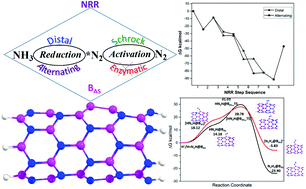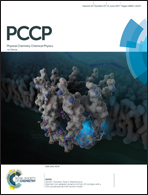Can boron antisites of BNNTs be an efficient metal-free catalyst for nitrogen fixation? – A DFT investigation†
Abstract
Nitrogen fixation is a challenging reaction under ambient conditions. So far, a few metal-based catalysts have been reported; however, noticeable disadvantages including high cost, gas poisoning, and them being hazardous to the environment are still to be resolved. We have carried out density functional theory based calculations with the ωB97X-D/6-31G* level of theory to investigate the activation of dinitrogen using boron nitride based metal-free catalysts for the first time as they are environmentally friendly and corrosion resistant. The boron antisite of a boron nitride nanotube is found to be an active site for nitrogen activation. The activated N2 is characterized by the increase in bond length and the red shift in the stretching frequency of the N![[triple bond, length as m-dash]](https://www.rsc.org/images/entities/char_e002.gif) N bond. The subsequent reduction mechanisms of activated N2 into ammonia through six-proton and six-electron processes have also been elucidated. The selectivity of the nitrogen reduction reaction between distal and alternating associative pathways is also rationalized. The reaction energetics highlight the distal associative mechanism as a feasible pathway under ambient conditions. The catalytic performance of BAS is further unraveled with the help of variation in the charge density. This work provides a rational model for the metal-free catalytic conversion of N2 to ammonia via an eco-friendly pathway under ambient conditions.
N bond. The subsequent reduction mechanisms of activated N2 into ammonia through six-proton and six-electron processes have also been elucidated. The selectivity of the nitrogen reduction reaction between distal and alternating associative pathways is also rationalized. The reaction energetics highlight the distal associative mechanism as a feasible pathway under ambient conditions. The catalytic performance of BAS is further unraveled with the help of variation in the charge density. This work provides a rational model for the metal-free catalytic conversion of N2 to ammonia via an eco-friendly pathway under ambient conditions.



 Please wait while we load your content...
Please wait while we load your content...